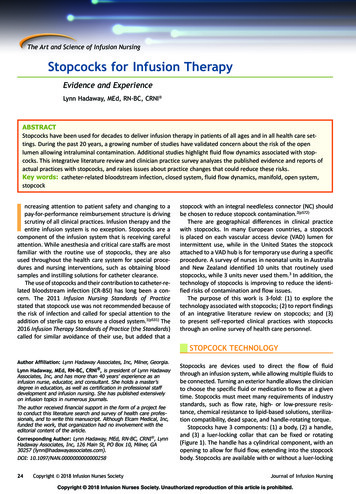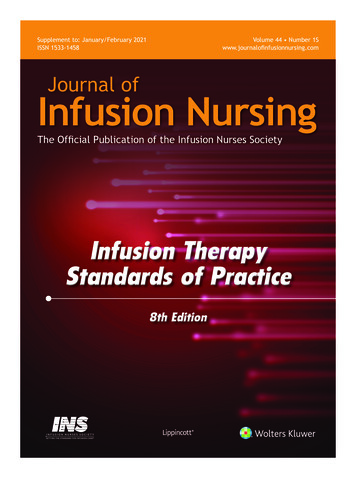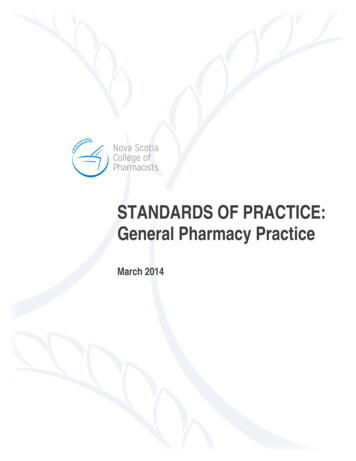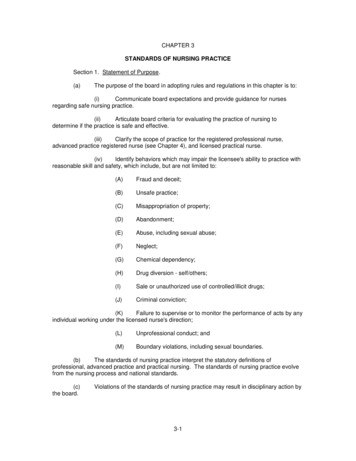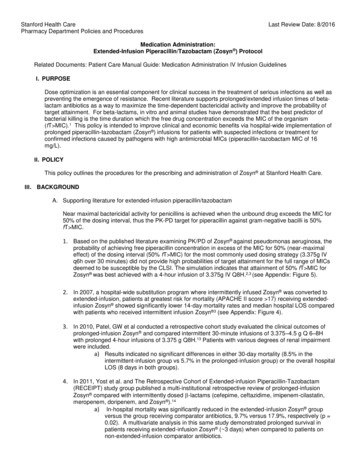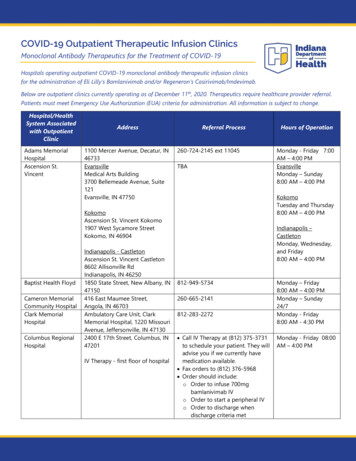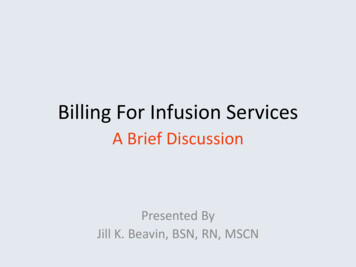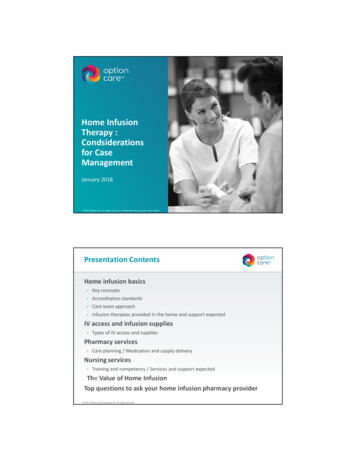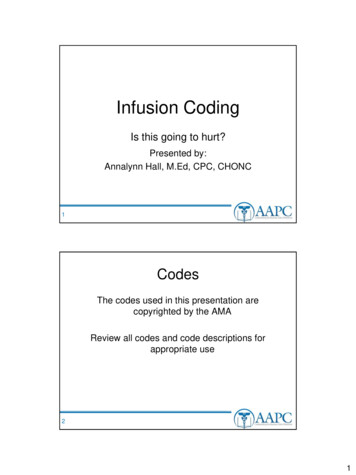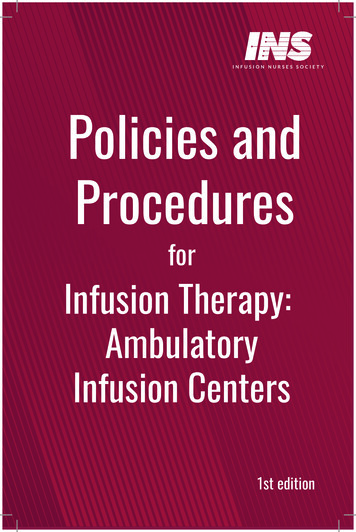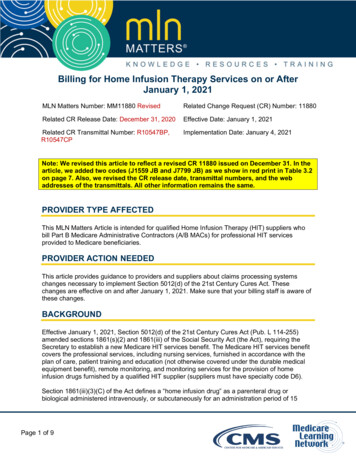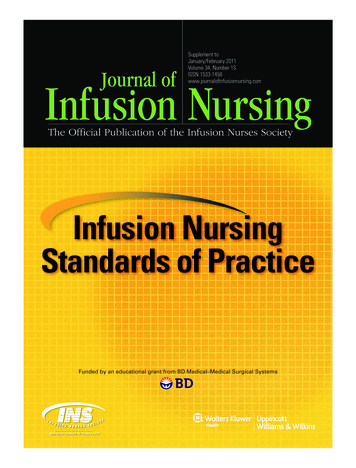
Transcription
Volume 34, Number 1SSupplement toJanuary/February 2011Volume 34, Number 1SISSN t to Journal of Infusion NursingInfusion NursingStandards of PracticeJanuary/February 2011Funded by an educational grant from BD Medical–Medical Surgical SystemsNANv34n7-Cover.indd 11/5/11 10:25 AM
INFUSION NURSING.qxp12/23/108:06 PMPage A1INFUSION NURSINGSTANDARDS OF PRACTICEDeveloped byInfusion Nurses SocietyREVISED 2011315 Norwood Park South, Norwood, MA 02062www.ins1.org
NAN v34n7 editorial-board.qxp12/23/107:51 PMPage A3Journal ofInfusion NursingJANUARY/FEBRUARY 2011EditorMary Alexander, MA, RN, CRNI ,CAE, FAANEditorial OfficeINS315 Norwood Park SouthNorwood, MA 02062(781) 440-9408(781) 440-9409 (fax)www.ins1.orgINS Board of DirectorsPresidentNancy Mortlock, BSN, RN,CRNI , OCN President-ElectJeanette Adams, PhD, ACNS,BC,CRNI Presidential AdvisorLynn Phillips, MSN, RN, CRNI Secretary/TreasurerMarvin Siegel, RN, CRNI Directors-at-LargeAngie Sims, RN, CRNI , OCN Mary Zugcic, MS, RN, ACNS-BC,CRNI Public MemberDavid Schmick, RPhINS Chief Executive OfficerMary Alexander, MA, RN, CRNI ,CAE, FAANInfusion Nursing Standards ofPractice ReviewersJeanette Adams, PhD, RN,ACNS,BC, CRNI Teri Aguiar, BSNSteve Bierman, MDCorrine Bishop, RN, CRRN, CRNI Volume 34 Number 1SPaul Blackburn, MNA, RNBeth Bonilla, BSN, MEd, RNCynthia Brown, RN, ARNP, GNPBC, CCRN, CRNI Heather Buxton, BSN, MSN,CNSRN, CRNI Gwen Cole, RN, CRNI Ann Corrigan, BSN, MS, RN,CRNI Ann Earhart, MSN, ACNS-BC,CRNI Charles Edmiston, PhD, CICSeth Eisenberg, BSN, RN, OCN Nina Elledge, MBA, RN, CRNI Beth Fabian, BA, RN, CRNI Michelle Fox, RNGina Gilbert, RNKevin Glover, MS, MEdDonna Gordon, MSN, RN, CRNI Richelle Hamblin, MSN, RN, CRNI Mark Hunter, RN, CRNI Pamela Jacobs, BSN, MHA, RN,CRNI , OCN William Jarvis, MDKenn Jones, BSN, RN, CRNI ,Debra Kovasevich, MPH, RNSandra Kronn, BSN, RN, CRNI Elizabeth Krzywda, MSN, ANPMelissa Leone, RNAlicia Mares, BSN, RN, CRNI Elizabeth Martinez, RNMary McGoldrick, MS, RN, CRNI Karen McKeon, RN, CRNI Katherine McKrill, RNPaula McMahon, RN, CRNI Nita Meaux, RN, CRNI Geno Merli, MDBritt Meyer, RN, CRNI Jeannette Meyer, MSN, RN, CCRN,CCNS, PCCNCrystal Miller, BSN, MA, RN,CRNI Susan Miller-Hoover, DNP, RN,CCNS, CCRNLibby Montoya, MSN, APN, CNSBCNancy Mortlock, BSN, RN, CRNI ,OCN Robin Nelson, MEd, RN, CRNI Barbara Nickel, APRN-CNS, CRNI ,CCRNThomas Nifong, MDShirley Otto, RN, CRNI , AOCNRoxanne Perucca, MSN, RN,CRNI Lynn Phillips, MSN, RN, CRNI Susan Poole, BSN, MS, RN,CRNI , CNSN, CICDebbie Potts, RN, CRNI , OCNKathy Puglise, MEd, RN, CRNI Laura Rutledge, RN, CRNI Pam Sabatino-Holmes, ARNP, RN,CRNI Ofelia Santiago, BSN, RN, CRNI Marvin Siegel, RN, CRNI Angie Sims, RN, CRNI Marc Stranz, PharmDVirginia Strootman, MSN, RN,CRNI Anne Swanson, RNJoseph Thomas, BSN, RNAlan Tice, MDCora Vizcarra, MBA, RN, CRNI Jeffrey Wagner, BSN, RNTimothy Weimken, MPH, CICSharon Weinstein, MS, RN, CRNI ,FACW, FAANMarcia Wise, RNMary Zugcic, MS, RN, APRN,BC,CRNI *CRNI is a registered trademark of the Infusion Nurses Certification Corporation.Proud Platinum Sponsor ofThe Journal of Infusion Nursing, the official publication of the Infusion Nurses Society (INS), seeks to promote excellence in infusionnursing by presenting new research, clinical reviews, case studies, and professional development information relevant to the practice of infusion therapy. Articles selected for publication represent the broad scope of the infusion specialty and draw on the expertise of all healthcare providers who participate in the delivery of infusion.
NAN v34n1S-TOC.qxp12/30/103:47 AMPage A5Journal ofInfusion NursingContentsNote: The “S” in page numbers denotes supplement issue and does not refer to a specific standard.AcknowledgmentsAbout the Standards ofPractice CommitteePrefaceStrength of the Body of EvidenceS1S2S4S5STANDARDS OF PRACTICENURSING PRACTICE1. Practice Setting2. Neonatal and PediatricPatients3. Older Adult Patients4. Ethics5. Scope of Practice6. Competence and CompetencyValidation7. Quality Improvement8. Research andEvidence-based Practice9. Policies, Procedures, and/orPractice GuidelinesS6S6S7S8S8S11S12S13S14PATIENT CARE10. Orders for the Initiationand Management ofInfusion Therapy11. Patient Education12. Informed Consent13. Plan of CareS15S16S17S18DOCUMENTATION14. Documentation15. Unusual Occurrence andSentinel Event Reporting16. Product Evaluation, Integrity,and Defect Reporting17. Verification of Productsand MedicationsS20S21S22S24INFECTION PREVENTION ANDSAFETY COMPLIANCE18. Infection Prevention19. Hand HygieneVOLUME 34 NUMBER 1SS25S26 20. Compounding of ParenteralSolutions and Medications21. Scissors22. Safe Handling and Disposalof Sharps, Hazardous Materials,and Hazardous Waste23. Disinfection of DurableMedical Equipment24. Transmission-based Precautions25. Latex Sensitivity or AllergyS27S2734.S2835.S29S29S30INFUSION EQUIPMENT26.27.28.29.30.31.Add-on DevicesNeedleless ConnectorsFiltersFlow-Control DevicesBlood and Fluid WarmersTourniquetsS31S32S33S34S35S36VASCULAR ACCESS DEVICESELECTION AND PLACEMENT32. Vascular Access Device Selection S37I. Short Peripheral Catheters S37II. Midline CathetersS37III. Central Vascular AccessDevices (CVADs)(Nontunneled, PICC,Tunneled, Implanted Port) S38IV. Arterial CathetersS3833. Site SelectionS40I. Peripheral Venous Access viaShort Peripheral Catheters S40II. Peripheral Venous Accessvia Midline CathetersS41III. Central Venous Accessvia Peripherally InsertedCentral Catheters (PICCs) S41IV. Central Venous Access viaNontunneled Central VascularAccess Devices (CVADs)S42V. Central Venous Access viaTunneled Central VascularAccess Devices andImplanted PortsS42JANUARY/FEBRUARY 201136.37.38.VI. Peripheral Arterial AccessVII. External Jugular VeinAccessLocal Anesthesia for VascularAccess Device Placementand AccessVascular Access SitePreparation and DevicePlacementI. GeneralII. Short Peripheral andMidline CathetersIII. Central Vascular AccessDevices (CVADs)IV. Arterial CathetersVascular Access DeviceStabilizationJoint StabilizationSite ProtectionS42S42S43S44S44S44S45S45S46S47S48ACCESS DEVICES39. Implanted Vascular AccessPorts40. Hemodialysis Vascular AccessDevices41. Umbilical Catheters42. Apheresis and UltrafiltrationCathetersS50S51S52S53SITE CARE and MAINTENANCE43. Administration Set ChangeI. GeneralII. Primary and SecondaryContinuous InfusionsIII. Primary IntermittentInfusionsIV. Parenteral NutritionV. Intravenous Fat Emulsions(IVFE) and Other LipidProduct InfusionsVI. Blood and BloodComponentsVII. Hemodynamic and ArterialPressure MonitoringS55S55S55S55S56S56S56S56
NAN v34n1S-TOC.qxp12/30/103:47 AMPage A6Journal ofInfusion NursingContentsNote: The “S” in page numbers denotes supplement issue and does not refer to a specific OMPLICATIONS47.48.49.50.51.PhlebitisInfiltration and ExtravasationInfectionAir EmbolismCatheter EmbolismThe Infusion Nursing Standards ofPractice is intended to reflectcurrent knowledge and practicesof the clinical nursing specialty ofinfusion therapy. Because clinicalpractice continually evolves basedon ongoing research, users shouldmake an independent assessmentof the appropriateness andapplicability of a standard in anyspecific instance, and should alsoconsider the applicable federal andstate laws and regulations, as wellas the standard of care in aparticular jurisdiction, as thesemay take precedence. INS is notresponsible for injury to personsor property, or other harm, arisingfrom the use of the Standards.S65S66S68S69S7052. Catheter-Associated VenousThrombosisS7153. Central Vascular Access DeviceMalpositionS72OTHER INFUSION-RELATEDPROCEDURES54. Vascular Access Device Repair55. Central Vascular AccessDevice Exchange56. Catheter Clearance: OccludedCentral Vascular Access Devices57. PhlebotomyI. Phlebotomy via DirectVenipunctureII. Blood Sampling via aVascular Access DeviceIII. Therapeutic PhlebotomyS75S75S76S77S78S78S79NONVASCULAR INFUSION DEVICES58. Intraspinal Access Devices59. Intraosseous Access Devices60. Continuous SubcutaneousInfusion and Access DevicesS84INFUSION THERAPIES61. Parenteral Medication andSolution Administration62. Antineoplastic Therapy63. Biologic Therapy64. Patient-Controlled Analgesia65. Parenteral Nutrition66. Transfusion Therapy67. Moderate Sedation/AnalgesiaUsing Intravenous Infusion68. Administration of ParenteralInvestigational 95S96S97S101S109S81S82Journal of Infusion Nursing (ISSN: #1533-1458) is published bimonthly for the Infusion Nurses Society by Lippincott Williams &Wilkins, Inc., at 16522 Hunters Green Parkway, Hagerstown, MD 21740-2116. Business and production offices are located atTwo Commerce Square, 2001 Market Street, Philadelphia, PA 19103. Periodicals postage paid at Hagerstown, MD, and at additionalmailing offices. Copyright 2011 by Infusion Nurses Society.Address for Subscription Information, Orders, or Change of Address (except Japan, India, Bangladesh, Sri Lanka, Nepal andPakistan): 16522 Hunters Green Parkway, Hagerstown, MD 21740-2116; phone 1-800-638-3030; fax 301-223-2400; in Maryland,call collect 301-223-2300. In Japan, contact LWW Igaku-Shoin Ltd., 3-23-14 Hongo, Bunkyo-ku, Tokyo 113-0033, Japan;phone: 81-3-5689-5400; fax: 81-3-5689-5402. In India, Bangladesh, Sri Lanka, Nepal and Pakistan, contact Globe Publication Pvt. Ltd. B-13,3rd FL, A Block, Shopping Complex, Naraina Vihar, Ring Road, New Delhi 110028, India; phone: 91-11-25770411; fax: 91-11-25778876.Annual Subscription Rates Worldwide: Individuals – US: 119.99; Canada: 131.43; UK, Australia: 151.11; Rest of World: 235.22. Institutions – US: 341.00; Canada: 390.52; UK, Australia: 420.99; Rest of World: 465.22. (The Canadian GST tax of 7%will be added to the subscription price of all orders shipped to Canada. Lippincott Williams & Wilkins, Inc.’s, GST IdentificationNumber is 895524239. The Canadian Publications Mail [CPM] Agreement Number is 40052291.) Subscriptions outside the UnitedStates must be prepaid. Single copies are 25.00. A 5.49 shipping and handling fee has been added to all subscriptions.Subscriptions outside North America must add 8.73 for air freight delivery. Prices are subject to change without notice. Copies willbe replaced without charge if the publisher receives a request within 90 days of the mailing date, both in the U.S. and worldwide.For commercial reprints and all quantities of 500 or more, e-mail reprintsolutions@wolterskluwer.com. For quantities of 500 orunder, e-mail reprints@lww.com or call 1-866-903-6951. Visit us on the web at www.lww.com.Postmaster: Send address changes to Journal of Infusion Nursing, P.O. Box 1550, Hagerstown, MD 21740.Text printed on acid-free paper.844. Vascular Access DeviceRemovalI. Short Peripheral CathetersII. Midline CathetersIII. Nontunneled CentralVascular Access Devices(CVADs)IV. Surgically Placed CVADs:Tunneled/Implanted PortsV. Arterial Catheters45. Flushing and Locking46. Vascular Access Device SiteCare and Dressing ChangesJournal of Infusion Nursing
Acknowledgments.qxd12/12/104:24 AMPage 1Journal ofInfusion NursingThe Art and Science of Infusion NursingACKNOWLEDGMENTSINS recognizes the significance that the Infusion Nursing Standards of Practicehas to clinical practice. Not only have the Standards been reviewed, revised,and updated, but this edition ranks the strength of the body of evidence to support each standard.First, I want to recognize the Standards of Practice Committee: Lisa Gorski, chair,Julie Eddins, Lynn Hadaway, Mary Hagle, Marcia Orr, Deb Richardson, and PennyWilliams. Without their knowledge and expertise, plus countless hours of researchand writing, this document would not have been completed. Their commitment tothis project is unsurpassed.Thanks go to the reviewers of the Standards. From INS members and committeemembers, physicians, pharmacists, legal advisors, health care clinicians, and industry partners, their thoughtful reviews and diverse perceptions added a uniqueperspective.I want to thank the INS Board of Directors for supporting the efforts of theStandards of Practice Committee during the entire revision process. I am also grateful to the INS staff for the assistance and coordination they offered in ensuring thatthis publication was completed.I also want to recognize BD Medical–Medical Surgical Systems for their continuous support over the years of the Standards of Practice revisions. INS thanks themfor the educational grant that helped to fund this project.Lastly, I want to thank our INS members. It is your passion and commitment toproviding quality patient care that motivates us to continue to provide products andservices that support your practice.Mary Alexander, MA, RN, CRNI , CAE, FAANEditorVOLUME 34 NUMBER 1S JANUARY/FEBRUARY 2011S1
About the Standards.qxd12/14/105:22 PMPage 2Journal ofInfusion NursingThe Art and Science of Infusion NursingABOUT THE STANDARDS OFPRACTICE COMMITTEELisa A. Gorski, MS, HHCNS,BC, CRNI , FAAN – ChairClinical Nurse Specialist, Wheaton Franciscan Home Health & Hospice,Milwaukee, WIMs Gorski has over 25 years of experience in home care and home infusion therapy, including patient care, nursing education, implementation of evidence-basedpractice in home care, research, and consultation. She is widely published and is theauthor of 3 textbooks specific to home infusion therapy. Ms Gorski also served asINS president from 2007 to 2008.Julie Eddins, MSN, RN, CRNI Staff Nurse, Barnes Jewish Hospital, St Louis, MOA critical care RN with 35 years in nursing, Ms Eddins has worked as a direct clinical provider of infusion therapy to general and intensive care patients, most recently to bone marrow transplant patients. She has presented programs both nationallyand internationally designed to educate professionals in the clinical application ofvascular access devices. She has been a contributing author for several nursing andinfusion therapy publications.Lynn Hadaway, MEd, RN,BC, CRNI President, Lynn Hadaway Associates, Inc, Atlanta, GAWith more than 35 years of experience in infusion therapy, Ms Hadaway broughtclinical experience as well as staff development, consulting, and regulatory expertise to this committee. Her areas of expertise include all aspects of vascular accessdevice management, complication prevention and management, and legal and regulatory issues. She holds national certifications in infusion nursing and professionalstaff development.Mary E. Hagle, PhD, RN, WCCNurse Researcher, Clement J. Zablocki VA Medical Center and the University ofWisconsin-Milwaukee College of Nursing, Milwaukee, WIWith 10 years’ experience as a nurse researcher and over 20 years as a clinical nursespecialist in academic and community medical centers, Dr Hagle has worked withpatients and nurses in acute care, ambulatory, and long-term care settings. Her clinical and evidence-based practice (EBP) focus has been on vascular access device andpain management with prevention of adverse events in medical/surgical and oncology practice. She has contributed to several textbooks on infusion nursing and evidence-based practice, as well as national guidelines on vascular access devices.S2Journal of Infusion NursingCopyright 2011 Infusion Nurses Society. Unauthorized reproduction of this article is prohibited.
About the Standards.qxd12/14/105:22 PMPage 3Marsha Orr, MS, RNDistance Education Faculty Liaison, California State University, Fullerton, School of Nursing(CSUF), Fullerton, CAMs Orr is an entrepreneur and consultant in the area of home infusion nursing, home medicalequipment, and medical gases, and is a home accreditation surveyor in these areas. Her specialtypractice areas include infusion therapy, vascular access, and nutrition support. She is currently afull-time faculty member in distance education at CSUF, a member of the technology staff, and apast board member of the American Society for Parenteral and Enteral Nutrition.Deb Richardson, MS, RN, CNSPresident, Deb Richardson & Associates, Houston, TXMs Richardson has over 30 years of experience in the field of vascular access and infusion therapy,including research, education, and evidence-based practices. She is an active member of several professional organizations; a frequent national and international speaker on vascular access; andauthor of multiple publications related to vascular access.Penelope A. Williams, MS, RN, CRNI Clinical Consultant; Adjunct Faculty for College of Lake County, ILMs Williams has over 30 years of experience in infusion therapy, clinical research, education, product development, management, and consulting in hospital practice, home care, academic, andindustry settings. She is a published author in her special interest of patient advocacy and is anactive member of several professional organizations.VOLUME 34 NUMBER 1S JANUARY/FEBRUARY 2011Copyright 2011 Infusion Nurses Society. Unauthorized reproduction of this article is prohibited.S3
NAN200144.qxd12/14/105:16 PMPage 4Journal ofInfusion NursingThe Art and Science of Infusion NursingPREFACEThe Infusion Nurses Society (INS) is recognized as the global authority ininfusion nursing, dedicated to exceeding the public’s expectations ofexcellence by setting the standard for infusion care. One pillar of INS’mission is developing and disseminating standards of practice.As the science and research of infusion nursing expands and technologyadvances, it is imperative that the Infusion Nursing Standards of Practice be currentand relevant. It provides the framework that guides our clinical practice. Therefore,it is important to integrate the best evidence and research available into each standard.Each standard provides criteria for nursing action and accountability, while thepractice criteria provide guidance for implementation of the standard. TheStandards are written to be applicable in all patient settings and address all patientpopulations. They are actions that must be followed in order to provide safe patientcare. Clinicians should be advised that the Standards is a legally recognized document.In this edition of the Standards, not only are the practice criteria supported bythe latest available research, but the strength of the body of evidence is also ranked.A ranking system was developed to identify the level of evidence and research thatsupports each of the practice criteria. The rankings range from Level I, whichincludes meta-analyses, systematic literature reviews, and guidelines based on randomized controlled trials, to Level V, which includes clinical articles, consensusreports, and generally accepted practices. Also, the practice criteria allow for moredetailed explanations for specific patient populations and practice settings.As nurses strive to meet the infusion needs of their patients in a complex healthcare environment, the Infusion Nursing Standards of Practice will be invaluable toguide decision making and for developing patient-centered plans of care.S4Journal of Infusion NursingCopyright 2011 Infusion Nurses Society. Unauthorized reproduction of this article is prohibited.
Strength of the Body of Evidence.qxd12/14/1011:32 PMPage 5Journal ofInfusion NursingThe Art and Science of Infusion NursingSTRENGTH OF THEBODY OF EVIDENCEEvidence that is research based is preferred; however, it may come from avariety of sources as needed. The strength of evidence in this documentreflects the body of evidence available and retrievable at the time ofreview, and thus is titled Strength of the Body of Evidence. The strengthof the body of evidence is only as robust as the highest level of a singleitem of evidence. Studies and other evidence comprise similar patient populationsunless otherwise noted. Regulatory evidence is kept separate since these criteria maychange based on changes in technology or body of research available.Strength ofthe Body ofEvidenceEvidence Description*IMeta-analysis, systemat
Infusion NursingJournal of Proud Platinum Sponsor of The Journal of Infusion Nursing, the official publication of the Infusion Nurses Society (INS), seeks to promote excellence in infusion nursing by presenting new research, clinical reviews, case studies, and professional development information releva
